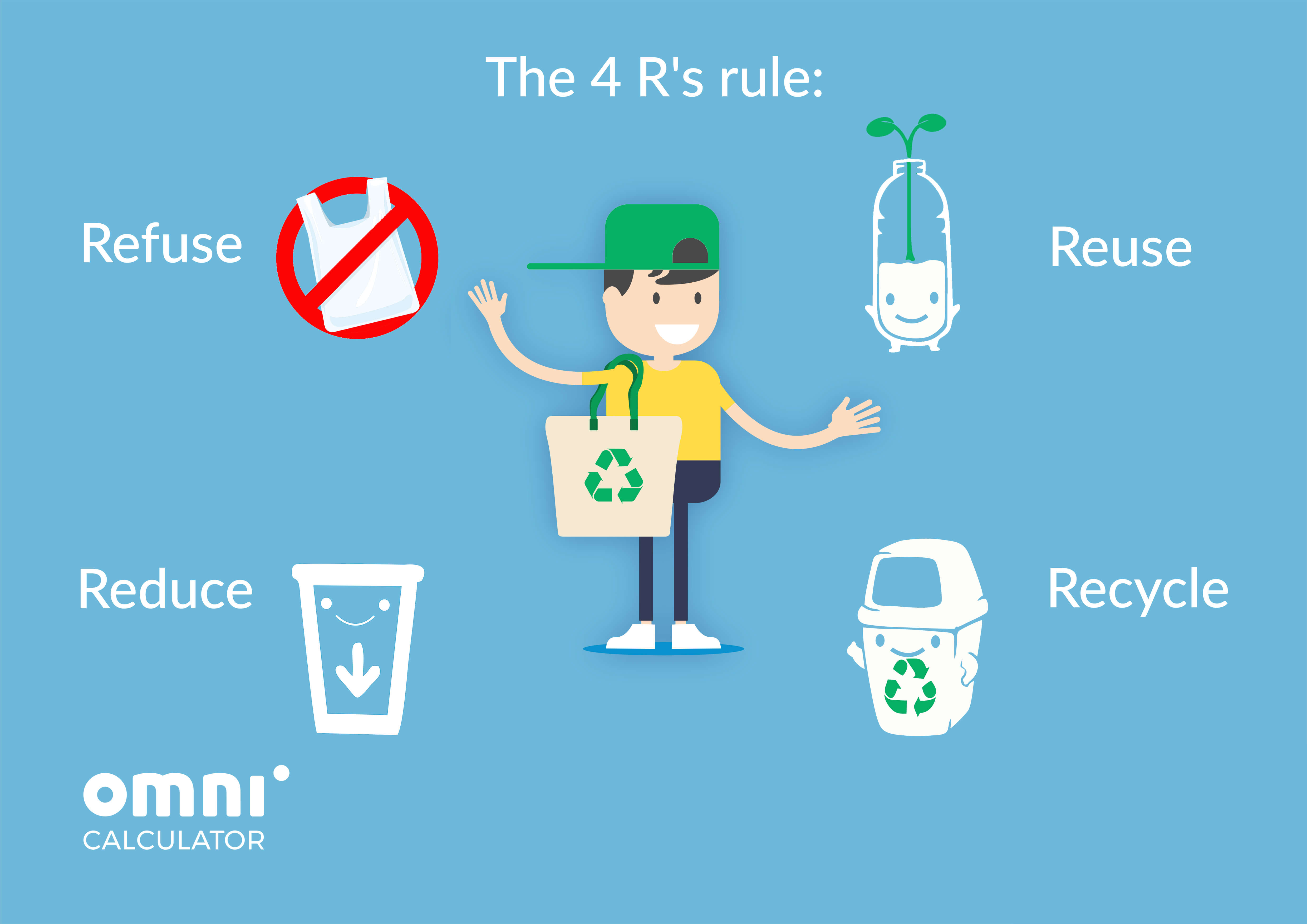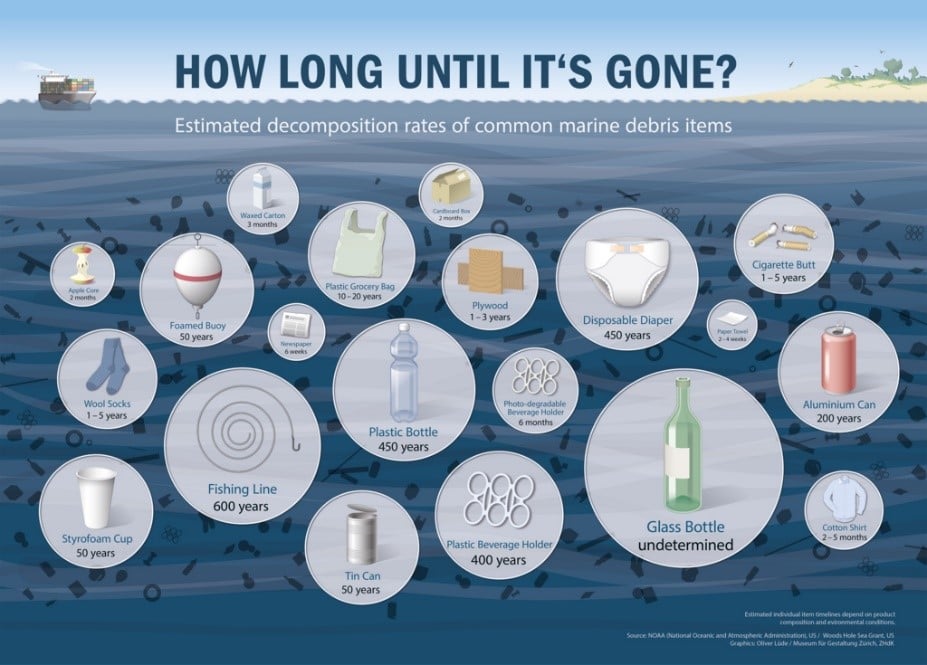The ubiquity of plastic is a terrifying fact – it’s everywhere around us: in the ground and in the oceans, in our food and in the water we drink. More than 8 million tons of plastic are dumped in our oceans every year; by 2050, we are going to have more plastic waste than fish. But what can we do about this? Isn’t this a problem just for big companies and industries? Of course not, remember that little drops make the mighty ocean! Inform yourself and others, be aware, change your lifestyle, take action. This plastic footprint calculator was created to help that – find out what your plastic usage will be in a year’s time. We encourage you to quit some bad habits and reduce the plastic footprint – believe it or not, but we can live without all these plastic bags, disposable cups, straws, and plastic bottles. If you are concerned about our future and the Earth we pass to the next generations, read on to find more information about plastic pollution.
How long does it take for plastic waste to decompose?
It is estimated that only 5-10 % of the world’s plastic is recycled. More than 30 % of it ends up in a landfill, and around one third – in the oceans. How embarrassing. We’ve even created a new continent – a mass of plastic waste the size of Europe. Have a look at this National Geographic short animation about plastic pollution – we are certain that after watching it, you’ll feel the need to change the world, step by step.
[REITs]Q1 hedge fund letters, conference, scoops etc
So, how long does it take for plastic garbage to decompose? Scientists estimate that plastic can take more than 500 years to degrade, but for the specific items this time can be shorter:
- plastic bag 10-1000 years
- grocery bag 10-20 years
- foam plastic cup – 50 years (have a look at this video: Plastic Pollution, Our Oceans, Our Future…)
- plastic disposable cup, plate – 400 years
- disposable diaper – 450 years
- plastic bottle – 450-500 years
Image source: futurism.com, on the basis of NOAA
The 4 R’s rule: Refuse, Reduce, Reuse, Recycle
The 4R’s is a rule to minimize and manage waste – it’s fundamental for those who really care about the world we are living in. How do you start?
- Refuse– turn down all disposable plastics, such as coffee cups, straws, plastic bags, single-use cutlery, and stirrers. You are using it for seconds or minutes, but it will outlive you by a couple hundred of years.
- Reduce– choose the products with the least possible plastic waste: choose paper-wrapped products over those packaged in plastic, buy biodegradable cotton swabs instead of the plastic ones (this innocent stick is one of the top ten forms of beach litter, polluting the oceans) and avoid plastic microfibers in things like synthetic clothing.
- Reuse(and repurpose) – use plastic containers as many times as possible. Take your lunch in a Tupperware-type box, reuse your non-toxic, durable straw, take a plastic bottle with you. Repurpose old plastic stuff – awaken your inner child and create a cool flower pot or a bird feeder.
- Recycle– if the options above don’t work, stick to the last one. Recycling plastic (and other materials) should be our everyday habit. Buy products which are made of recycled materials, choose ones which are easy to recycle, and rinse your waste before throwing it into a recycling bin to avoid waste contamination, which makes recycling impossible.
Sometimes it’s even called the 5 R’s rule – the last R standing for Rot, Repurpose or Remove, depending on the source.
How to calculate plastic footprint?
If you are wondering what your yearly plastic consumption is, check out the plastic footprint calculator:
- Start from your everyday needs and shopping habits. How many plastic bags do you take when grocery shopping? How many water bottles do you buy each week? Count all of them and type the values into the proper boxes. Let’s assume that you buy 3 PET bottles per week (coke and water), 5 plastic bags (Refuserule!), 8 food wrappers, and 2 yogurt containers.
- Let’s move to the laundry, cleaning, and bathroom. Type the values that describe your needs, e.g., 4 cotton swabs/week and 4 detergents, 2 shampoo bottles, 2 refill packets per half year. Add the toothbrushes and toothpaste – in our example it’s 3 per year for both of them.
- Add all disposable wastes and takeaway containers. Take-away lunch four times per week (don’t forget about the cutlery pieces), grabbing a coffee on the go twice per week, a couple drinks with straws and a plastic plate on a Sunday barbecue… Urgh, it’s a lot. We know it’s quick and convenient, but it’s the most shameful plastic waste you can easily avoid. Rethink, refuse a straw, reduce the trash, and bring your own container every time you can.
- Plastic footprint calculator will add all the plastic you used throughout the year. In our example, it summed up to 64 pounds (29 kg), and the average for a European citizen is 68 pounds (31 kg). That’s a heck of a lot of plastic! To make it worse, we can tell you that this footprint is still relatively small if you are living in the US: the average American throws away approximately 185 pounds (84 kg) a year! Multiply this by 300 million US inhabitants, and you will understand why plastic pollution is such a pressing issue.
Remember that the plastic footprint calculator features only the basic products – your plastic footprint may be much higher if you add some other products, e.g. plastic furniture, boxes, crates, buckets, flower pots, bowls, or any other plastic items.
How can I reduce my plastic footprint?
Well, you can do a lot about that. Take the 4 R’s pledge and start from small things:
- Refuse the plastic bags and bring your own cloth bags.Keep a cotton bag in your backpack, in the car trunk, next to the front doors – where it’s easy to notice and grab it when you’re going shopping.
- Bring your mug.In only the UK, 7 million disposable coffee cups are used every day. On top of that, they need to be recycled in specialized facilities, as they are made not from standard paper but from paper lined with plastic to provide waterproofness. It’s estimated that less than 1% of disposable cups is recycled. Not to mention the plastic lids, sleeves or stirrers.
- Refuse the plastic straws or change to those made from paper or steel. For most people (excluding hospital patients), drinking with a straw is not a must. Did you know that plastic straws make up ~4% of the plastic trash by piece? Of course far less by weight, as they weigh approximately 0.18 oz (0.5 g), but this doesn’t stop them clogging up our oceans. Take this small step and boycott plastic straws today.
- Use refill packets instead of buying new bottles every time. Every time it’s possible, choose the products which generate less plastic waste. You can check with our plastic footprint calculator how much plastic you will ‘save’ when using refill packets. It’s around four times less, as detergent bottles are usually made from heavier HDPE (high-density polyethylene).
- Carry your own water bottle. Choose a reusable plastic or glass bottle. Your footprint will be reduced, and you will be shocked how much you can save if you drop the bottled water! Check our tap vs. bottled water calculatorto find out what substantial savings result from such a tiny change.
Don’t wait any longer, change your habits today. Find out what’s your travel carbon footprint and try to live the greener life.
Article By Hanna Pamuła – PhD candidate.






